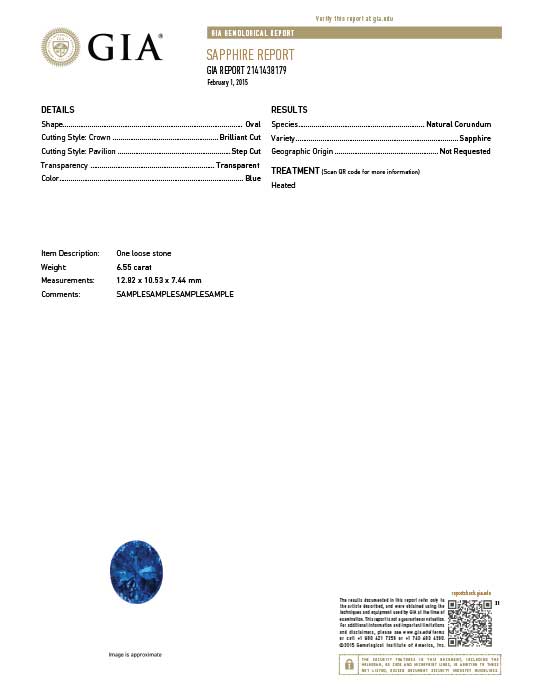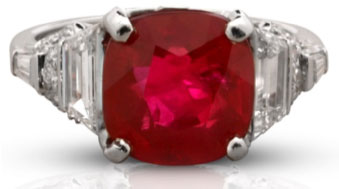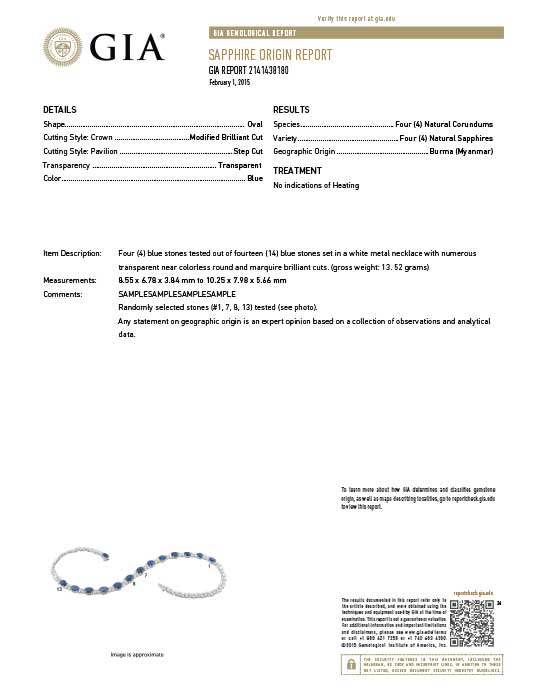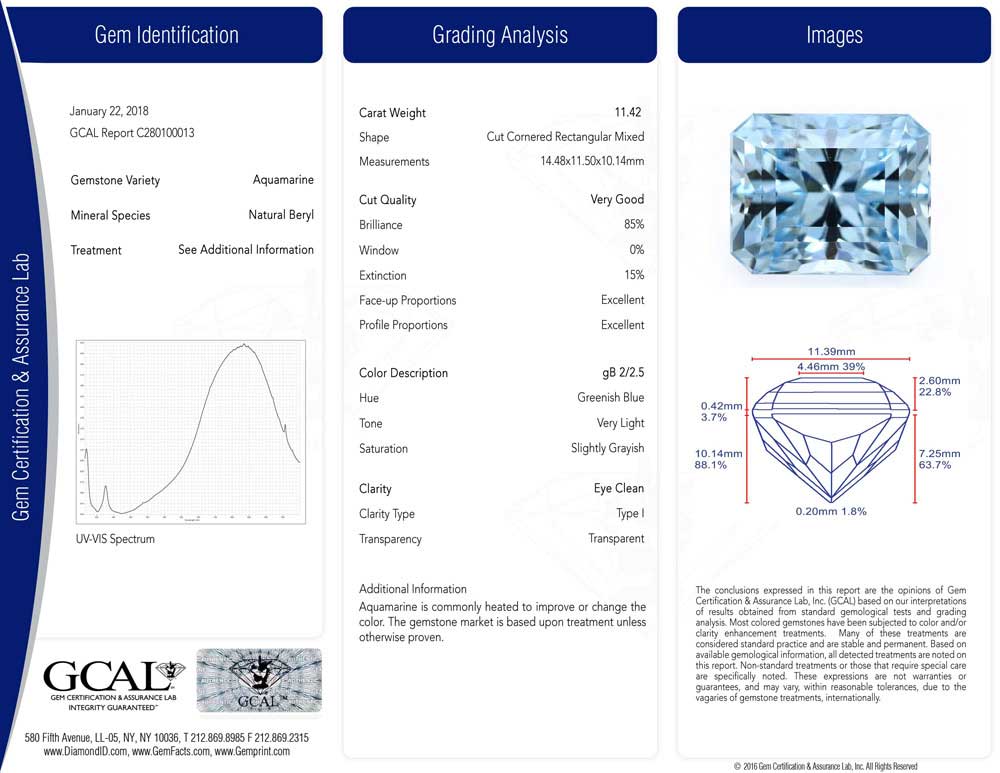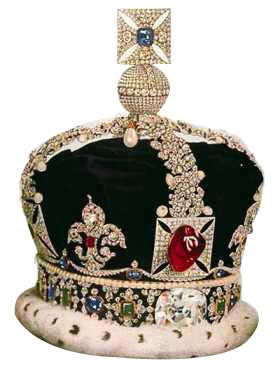Lab reports for colored gems
GIA is a highly respected lab for grading diamonds—and we have consistently recommended them.
What about GIA's lab reports on colored gems? That's another story.
Color
Color, in all its variations and subtleties, accounts for as much as 50% of a colored stone's value. This means a gem's color description should be as precise as possible.
In earlier times, acceptable descriptions were more poetic than precise. A ruby might be the color of "pigeon's blood," a sapphire might be "sky blue" or "cornflower blue."
These days such terms are inadequate and both jewelry owners and insurers need more specific descriptions.
In the early 20th century Albert H. Munsell, an American painter and art instructor, identified three basic qualities of color: tone, saturation and hue. Any color can be specified by naming these three qualities.
Based on Munsell's classification, GIA developed a Colored Stone Grading System. This grading system uses very specific terms to describe a gem's color.
An emerald's color, for instance, might be described as "very slightly bluish Green" hue, "Medium Light" tone, and "Very Slightly Grayish" saturation. It's not up to an insurance professional to be able to picture the color from this description, but this terminology would be meaningful to a trained gemologist appraiser who is arriving at a valuation or judging whether a replacement stone is of like kind and quality as the lost gem.
GIA teaches this system to its gemology students, who are encouraged to use it on their appraisals. For years it has sold colored stone grading tools.
But the GIA's Colored Stone Grading System is not used on GIA's own reports!
Here is a sample Identification Report from the GIA website. The sapphire's color is given as simply "blue."
It's true that sapphire can come in any number of colors; in the corundum bracelet at the top of this page, the red stones are rubies and all the other colors are sapphire. Yet "blue" is not a sufficient color description, because subtle variations in color are intrinsic to the gem's quality and can greatly impact its value.
On its website, GIA has this to say about the impact of sapphire's color:
Color has the most important influence on blue sapphire's value. The most highly valued blue sapphires are velvety blue to violetish blue, in medium to medium dark tones. Preferred sapphires also have strong to vivid color saturation. The saturation should be as strong as possible without darkening the color and compromising brightness. Sapphires with these qualities command the highest prices per carat.
We'd like to know the details of this sapphire's blue, but they are not revealed on the GIA lab report. Why not?
It turns out that, for colored stones (unlike for diamonds), GIA does not issue "grading" reports. GIA offers this explanation on its FAQ page:
The grading of colored stones is a highly complex process with countless variables. Unlike GIA's diamond grading system, no one grading system has been embraced by the trade.
How can GIA teach color grading, teach GIA's own Colored Stone Grading System, and even sell color-grading tools to its students, while taking the position that color grading is too complex for its own lab reports?
The Identification Report identifies the stone as natural (that is, mined, not lab-made) sapphire, discloses that it has been heat-treated (which is a common treatment for sapphire), gives its measurements, etc., but the subtlety of color—which accounts for 50% of the gem's value—is left at basic blue.
Geographical Origin
Colored gemstones contain characteristic trace elements from the environment in which they formed. These trace minerals can contribute to the beauty of the stones. Gems from certain areas, such as rubies and sapphires from Burma and Kashmir, are highly valued.
If a gem is purported to be a Burmese ruby, for example, the customer (and insurer) should have independent verification of its origin from a competent authority. GIA has the equipment and expertise to make such a determination and reveals its findings in an Origin Report.
It should be noted, however, that not all sapphires from Kashmir or rubies from Burma are equal. Their value depends on the stone's specific qualities—including the particulars of its color.
Rubies and sapphires are commonly heat-treated to improve their color; however, gems of a similar color that have not been heated are more valuable. Therefore, a lab report should note the presence or absence of heat treatment. GIA does so, on both its Identity Report and its Origin Report .
This sample Origin Report is for sapphires from Burma. But other than stating the stones' geographic origin, GIA's Origin Report is exactly like the Identification Report. Both reports describe the sapphires as simply "blue."
(A note about diamonds: The geographical location of the mine is relevant only for colored gems. The region where a diamond was mined cannot be discovered by inspection of the stone because diamond forms deep in the earth's mantle and is not affected by other minerals in the area of the mine.)
Lab reports are useful to verify and supplement information on the sales receipt or appraisal. Because GIA's colored stone reports lack color grading, they are of limited use and we cannot recommend them.
GCAL's Grading Report
The GCAL report, in this sample from the GCAL website, is for an aquamarine. The report gives a description of color in terms of tone, saturation and hue (and also gives a color description code, based on the GCAL grading system). There is also a diagram showing measurements and other useful descriptive information.
Be sure you get GCAL's Grading Report, as their Identification Report is much more bare-bones.
Appraisal
A good appraisal, written by a trained gemologist appraiser, should include a detailed description of the stone in terms of tone, saturation and hue.
Most jewelers deal primarily with diamonds. Not every jeweler, nor even every trained gemologist, is competent to appraise colored gems. A reliable appraiser of colored gem jewelry is one who is familiar with the buying and selling of colored gems, who knows the market for the gem in question, and who is aware of treatments and frauds associated with that gem.
The best appraisal includes the JISO 78/79 appraisal form and is written by a qualified gemologist (GG, FGA+, or equivalent), preferably one who has additional insurance appraisal training. One course offering such additional training is the Certified Insurance Appraiser™ (CIA) course of the Jewelry Insurance Appraisal Institute.
FOR AGENTS & UNDERWRITERS
For colored gem jewelry, the appraisal should describe the gem in proper gemological language for tone, saturation and hue. It should state whether the gem is mined or lab-grown, and it should list all treatments or state that the gem is untreated. The submission should include one or more photos of the jewelry.
Some jewelers and appraisers may use other grading systems or even a nomenclature of their own. This is unacceptable. The GIA Color Grading System is standardized and widely understood, even though GIA reports do not use it.
Most jewelers and appraisers are experienced primarily with diamond jewelry. For colored stones, it is essential that the appraisal be written by a gemologist experienced with colored gemstones and familiar with current pricing, treatments and frauds.
Preferably, the appraisal should be on JISO 78/79 form, written by a trained gemologist (GG, FGA+, or equivalent), with additional insurance appraisal training. One course offering such additional training is the Certified Insurance Appraiser™ (CIA) course of the Jewelry Insurance Appraisal Institute.
FOR ADJUSTERS
While there are fewer claims on colored gems than on diamonds, colored stones usually have much higher markups and generally have inflated valuations. Most consumers are totally unfamiliar with colored stones, and the pricing abuses are great.
Compare the sales receipt with the appraisal. If there is a great discrepancy between selling price and valuation, the selling price probably reflects value more accurately.
If the sale price seems too low for the appraised value, it's possible that the gem was fracture-filled, or was synthetic, or was a lower-value substitute, such as spinel passed off as ruby.
Check all documents for mention of color treatments or clarity treatments. Treated (also called "enhanced") gems have a significantly lower value than untreated gems of similar appearance.
©2000-2024, JCRS Inland Marine Solutions, Inc. All Rights Reserved. www.jcrs.com



